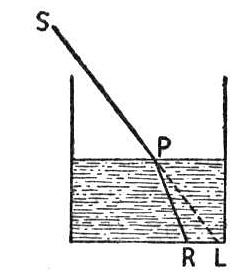 Wait a minute!? Isn’t the speed of light constant?
Wait a minute!? Isn’t the speed of light constant?Yes. But only in a vacuum.
If you shoot light through glass, it travels only 0.67 times its original speed and if you shoot light through water it travels only 0.75 times its speed in a vacuum (in beer, light travel 0.74 times as fast, though one would imagine this to differ slightly from, say, porter to pilsner...hmmm, research needed).
And the more you slam on the brakes, the more light changes direction. You can see this when you stick a straw in a glass.
Refraction is also responsible for rainbows: as white sunlight refracts through atmospheric water, each frequency contained within this white light adopts a slightly different speed and thus refracts slightly more or less, spreading out into the immediately recognizable ROY-G-BIV spectrum.
Thus, as seen in the diagram, if you are trying to shoot a fish at position R, it—in fact—appears at position L and you will need to aim lower than it appears in order to hit it.
Note: shooting fish drastically decreases the chance of successful catch and release.
Join me every Monday morning for more grandtastic goodies from The Geeks' Guide to World Domination. Or if you like your geekery delivered fresh, consider subscribing to my rss feed or joining my Facebook Fan Page.






Comments